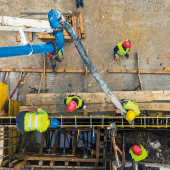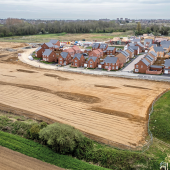Clip and build

Who exactly are the building safety managers – the new professional role safeguarding HRRBs that has emerged from the plethora of reviews, working groups and consultations produced since the Grenfell tragedy? Elaine Knutt reports
Even as job adverts appear for first-generation building safety managers (BSMs), most people in the industry will have only a hazy idea of which individual skills are required to slot into which organisational needs, or indeed if the scope it suggests is best provided as a corporate service.
Still, with about 13,000 high-risk residential buildings (HRRBs) covered by forthcoming legislation, and the Ministry of Housing, Communities and Local Government estimating a maximum ratio of one BSM for every ten HRRBs, there could be a need for at least 1,300 qualified and certified individuals to act as building safety managers. As property owners and housing providers have the option to appoint a third-party organisation to provide “building safety management as a service” – whereby a named individual BSM could manage more properties if supported by specialist teams – that figure is only a guide.
The role is defined in the Building Safety Bill, but that legislation is awaiting its second draft before it can embark on the parliamentary process. BSMs will then join the statutorily defined roles of principle contractor and principle designer. Definitive guidance on how their skills should map to their legal duties and liabilities will only be available once three forthcoming Publicly Available Specifications (PAS) are published by the British Standards Institute.
Within the new regulatory system it will be the responsibility of the accountable person (AP), the duty holder, to appoint a BSM prior to occupation. The BSM will be a regulated role and have its own obligations under the forthcoming act. However, many of these are carried out in support of the AP to assist them in fulfilling their duties. The primary responsibility of the BSM is to ensure the building is managed in accordance with the safety case report, once this has been agreed by the regulator.
In practical terms, the building safety manager’s responsibilities will include updating HRRB building safety files (the golden thread), assisting the AP in compiling and submitting safety case reports to the new regulator, and ensuring ongoing compliance with the regulator-issued Building Assurance Certificate.
It had been argued – including in Building Engineer – that they should also cover additional aspects of HRRB safety, such as maintenance works, Legionella and ventilation. However, the Ministry of Housing, Communities and Local Government has opted against the wider shake-up in legal responsibilities this implied. BSMs will need to comprehend and be comfortable operating across these boundaries and with other duty holders.
“The title is building safety manager, not fire and structural safety manager – so their competence has to reflect wider issues,” says Anthony Taylor, an accredited mediator and Chair of Working Group 8 of the Competence Steering Group, one of 13 working groups that sought to define new skills and certification pathways in the industry.
Still, despite there being so much doubt over the exact parameters of the role, there appears to be a growing appetite to scope out its requirements and the demands of the regulatory regime behind it. Sofie Hooper, Head of Policy at the Institute of Workplace and Facilities Management (IWFM), who acted as joint secretary of Working Group 8, describes how the IWFM recently held a webinar on the subject that attracted 200 registrations within two hours of the booking process opening. “The awareness levels are much higher. It feels like people are very much waking up to some of the requirements,” she says.
Setting the bar
The industry-proposed competence framework for future BSMs is set out in Annex 8a of Setting the bar (full report: Safer people, safer homes: building safety management), the overarching report on re-skilling the construction professions in the wake of the Grenfell tragedy. Annex 8a was produced by Working Group 8, which tackled the BSM role, drawing on representation from organisations in the property management, fire safety and social housing worlds.
It defines six competence areas: building systems, building operations, risk management, leadership and planning, operational practice and monitoring and control. Each has six sub-competencies, with the framework also specifying whether these must be at foundation, intermediate, advanced or specialist level. This structure will also form the scaffolding for the forthcoming PAS.
While competence in these areas need not imply Masters-level skills, individuals will still need to be conversant in various technical dialects. “They will not have to be competent in all skillsets but they need to be competent enough to be confident to challenge the experts delivering information to them. For instance, a fire safety manager who wants to be a BSM might know little about facilities management or Legionella,” Taylor says. “We anticipate them coming from a wide range of professional backgrounds, so it’s important they get up to scratch on the other skills in Safer people, safer homes.”
As Taylor points out, any would-be building safety manager will have to identify gaps in their skills in relation to the competence framework, and ultimately the PAS, then backfill these with CPD, professional courses or training. Hooper says that interested parties can embark on this straight away. “Upskilling won’t happen immediately, so they can use the Working Group 8 framework to assess where they are strong and not so strong to embark on a course or to study.” But she adds: “People can look at upskilling and formalising that upskilling, but without the PAS we can’t have certified people.”
Then there’s the matter of resident engagement. Giving residents a voice on safety issues affecting their homes has been a key organising principle of the new legislation, in reaction to the institutional deafness of Kensington and Chelsea Tenant Management Organisation, which was responsible for Grenfell Tower. Turning a historic weak point into a central pillar of the new regime, residents and tenants will be able to raise complaints against BSMs and escalate these to the Building Safety Regulator if they are dissatisfied with the response. Still, it remains to be seen how this will work in practice.
Read the second part of this article in our April issue.
UK variations
- Currently building safety managers are England only
- Wales is currently consulting on introducing requirements for building safety managers (though precise detail may vary)
- Scotland is considering a similar system but has not released details yet
- Northern Ireland is assessing the need for BSMs and will make a decision later in the year.









